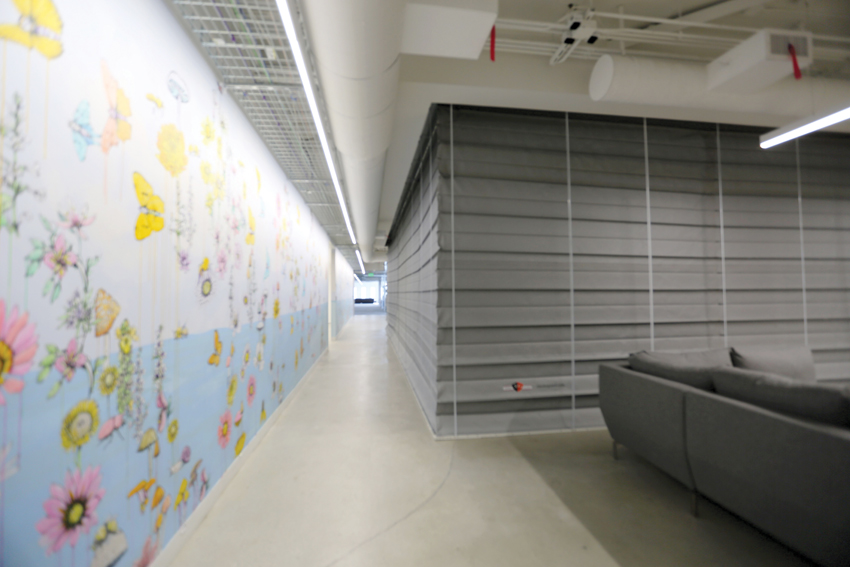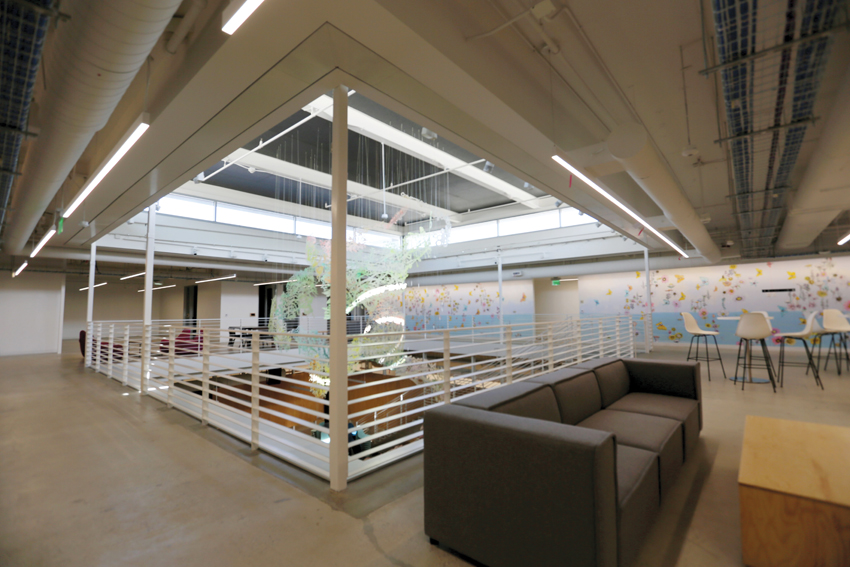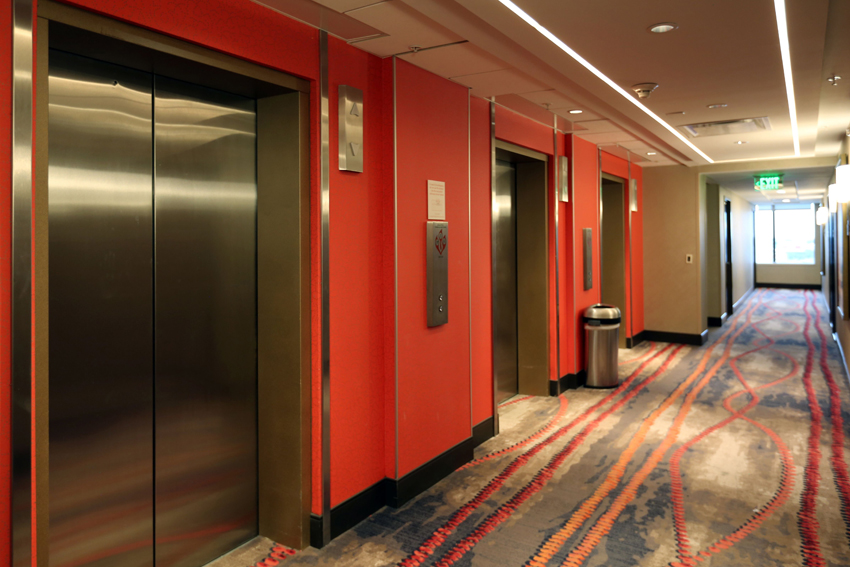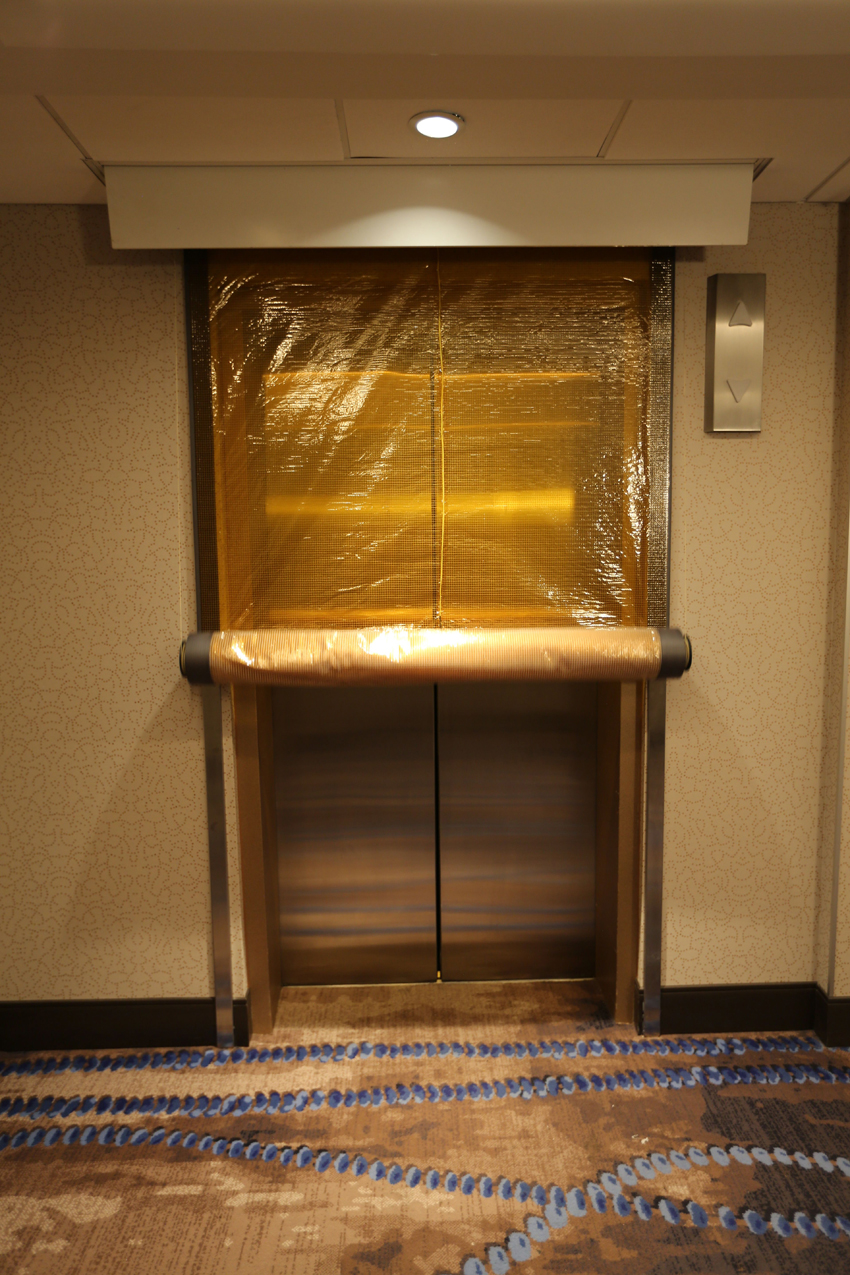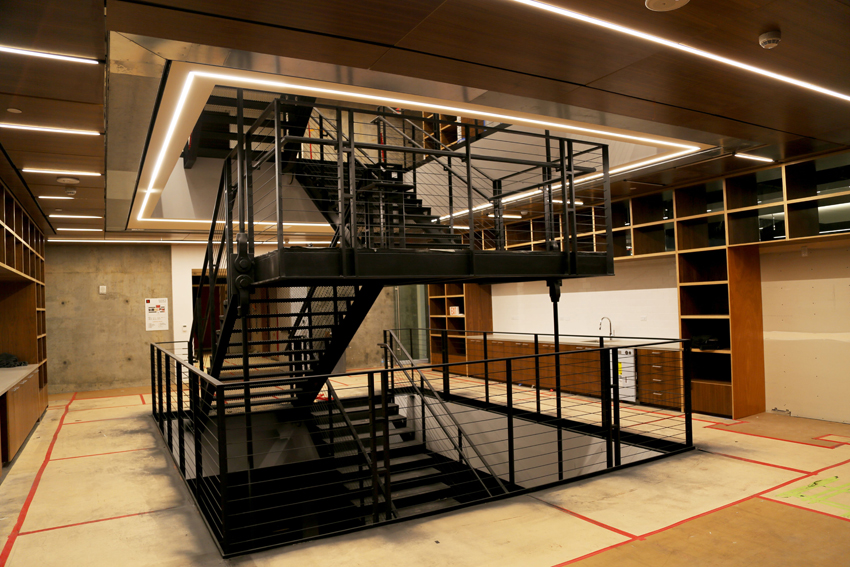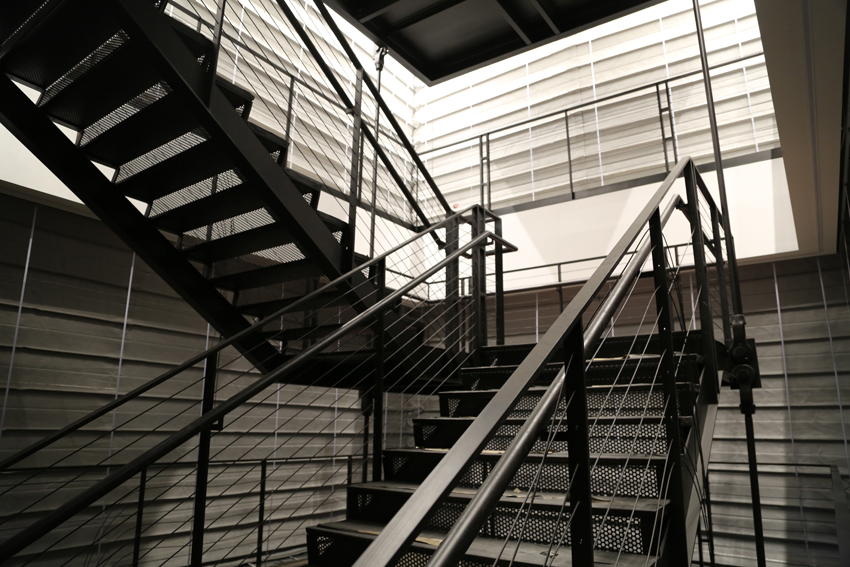Deployable Fire- and Smoke-Protection Solutions
A closer look at the space-savvy systems delivering safe and code-compliant interiors
![]() Continuing Education
Continuing Education
Use the following learning objectives to focus your study while reading this month’s Continuing Education article.
Learning Objectives - After reading this article, you will be able to:
- Explain the fire- and smoke-related criteria that must be satisfied at elevator hoistways to create a design that is compliant with the 2018 International Building Code (IBC).
- Explore the similarities and differences in the fire- and smoke-protective measures that must be incorporated, per the IBC, into the vertical openings described as two-story spaces and an atriums.
- Identify the limitations of traditional smoke- and fire-rated solutions, such as enclosed elevator lobbies, elevator pressurization systems, compartmentalization, and smoke evacuation systems.
- Describe how rolling magnetic gasketing systems and fire- and smoke-rated vertical, horizontal, and perimeter curtain systems enable architects to meet fire and life-safety codes while delivering open and spacious interiors.
Elevator hoistways and other multistory openings, such as atriums and open staircases, require special attention to prevent the vertical migration of smoke and fire in the event of an emergency. Unfortunately, traditional fire- and smoke-management solutions such as enclosed elevator lobbies, elevator pressurization systems, compartmentalization, and smoke evacuation systems undercut an architect’s ability to create the open floorplan desired by so many building owners and can seriously strain a project’s budget. A new solution is gaining momentum in designs around the United States that delivers both the life-saving functionality demanded during a fire event and the out-of-sight, out-of-mind, design-supporting presence dreamed of by architects and owners alike during typical day-to-day operations.

All images courtesy of Smoke Guard
New deployable solutions in fire and smoke containment enable architects to create more space-savvy, open designs while satisfying the latest life-safety codes.
A deployable smoke- and fire-rated curtain strikes the delicate balance of safety and aesthetics. This system can offer the protection against vertical smoke migration required by the various codes during an emergency. When unneeded, the system is stored in a retracted position that leaves spaces clear and open.
This course will explore the advantages of using flexible fabric solutions to satisfy fire- and smoke-related code requirements at vertical openings throughout a building and describe how these systems are being employed by design firms in high-profile projects to create the safe, corporate-culture-forward, awe-inspiring interiors that their industry-leading clients demand.
FIRE AND SMOKE SAFETY CODES
The fire and life-safety codes designed to stem vertical smoke migration that architects must meet today were, in many cases, informed by hard lessons learned in the aftermath of great tragedies. For example, codes that require multiple protected means of egress in hotels were first introduced after the fire at the Winecoff Hotel in Atlanta in 1946.
Built in 1912, the Winecoff had been advertised as fireproof, a claim made in reference to its revolutionary steel construction. However, in the early morning hours of December 7, 1946, a fire erupted on the third floor of the 15-story structure. The one, single stairway serving all 15 floors was compromised, trapping guests above the third floor in the burning building. Deemed the deadliest hotel fire in U.S. history, 119 people died that night. The disaster sparked a national outcry for a better, more concentrated effort dedicated to preventing fire-related losses of life and property. The National Conference on Fire Prevention was created by President Harry Truman the following year, in 1947. New life-safety requirements emerged from the conference, such as requiring multiple protected means of egress and self-closing fire-resistive doors. These two key provisions were quickly adopted across the United States.
Since then, life-safety codes have proliferated to address the importance of controlling the spread of fire and smoke throughout a building. Today, there are various building and fire codes that can be adopted, including the International Building Code (IBC), written by the International Code Council (ICC); NFPA 5000: Building Construction and Safety Code, written by the National Fire Protection Association (NFPA); and NFPA 101: Life Safety Code, also written by NFPA. These codes define the minimum fire-prevention performance and design elements that must be incorporated into a structure. Items within their sphere of influence include structural integrity, ventilation, means of egress, fire prevention, and smoke containment, among others.
Smoke containment is an especially important aspect of life safety because in a fire event, smoke inhalation often causes more fatalities than fire exposure. The goal of smoke containment is to prevent the movement of smoke and heat from one area to another, allowing building occupants to escape safely and making it easier for firefighters to address the fire. When a fire starts, a smoke plume made up of hot gases and smoke rises until it reaches the ceiling, where it starts to spread out horizontally. However, the smoke and hot gas want to continue to rise, and that is exactly what they do whenever they reach areas of the interior building structure that will allow it. A fire that starts on the third floor of a hotel, for instance, will reach the stairwell and climb higher and higher, breaching floors far above where the fire originated, just as it did in the fire at the Winecoff.
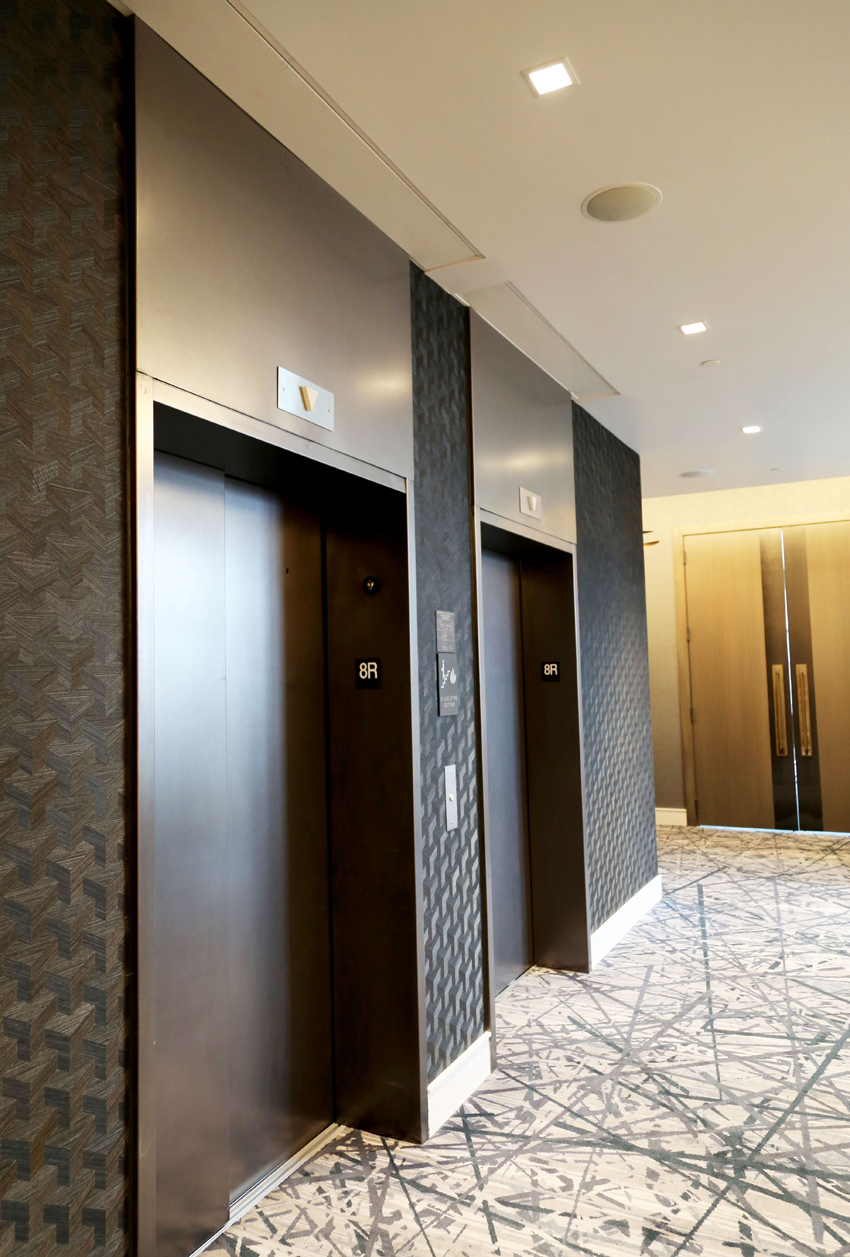
Elevator shafts can act like chimneys in multistory buildings, and smoke migration must be contained in the design.
In elevator hoistways, smoke migration can be far more dramatic and deadly. Elevator shafts act like chimneys in multistory buildings, enabling large quantities of air to move from floor to floor. When a fire occurs, the shaft serves as a conduit, transporting smoke throughout a building. The heated smoke enters the elevator shaft from the fire floor and rises, displacing the resident cooler, denser air. Stack-effect pressures in the elevator hoistway draw this cool smoke up through the vertical shaft. As the smoke rises, it easily leaks back through the elevator doors and onto other floors, exposing occupants on upper floors to this dangerous and toxic hazard. For this reason, building codes have special smoke-containment equipment that must be incorporated into areas like elevator hoistways, open stairs, and multistory spaces to prevent the dangerous vertical migration of smoke.
2018 International Building Code (IBC 2018)
The fire- and smoke-related provisions in the IBC have remained fairly consistent over the past 20 years. In IBC 2015, there was a significant reorganization and clarification of the requirements for the elevator hoistway. Now, the requirements that regulate vertical and horizontal transportation and the material-handing systems installed in buildings is found in Chapter 30, moved from Chapter 7, where they were previously located. This chapter also provides regulations for several elements that must be present to protect occupants and assist emergency responders during fires. In IBC 2018, the most recent iteration, Section 3006 specifically details the opening protection required at elevator hoistways and rated corridors. It is important to note that there are other reasons that an elevator may require smoke protection. If, for example, a corridor is required to be fire rated by the IBC's Chapter 10: Means of Egress, then an elevator opening into that corridor is required to be smoke rated. In addition, if an occupancy is required to have smoke compartments and an elevator opens into that smoke compartment, then the elevator must offer smoke protection.
Section 3006.2: Hoistway Opening Protection Required
This section of the code states, “Elevator hoistway door openings shall be protected in accordance with Section 3006.3. Where an elevator hoistway connects more than three stories, it is required to be enclosed within a shaft enclosure in accordance with Section 712.1.1 and any of the following conditions apply:
- The building is not protected throughout with an automatic sprinkler system in accordance with Section 903.3.1.1 or 903.3.1.2.
- The building contains a Group I-1, Condition 2 occupancy.
- The building contains a Group I-2 occupancy.
- The building contains a Group I-3 occupancy.
- The building is a high-rise, and the elevator hoistway is more than 75 feet in height. The height of the hoistway shall be measured from the lowest floor to the highest floor of the floors served by the hoistway.”
Section 3006.2.1 Rated Corridors
This section of the code states, "Where corridors are required to be fire-resistance rated in accordance with Section 1020.1, elevator hoistway openings shall be protected in accordance with Section 3006.3."
Section 3006.3: Hoistway Opening Protection
This section of the code states, “Where Section 3006.2 requires protection of the elevator hoistway door opening, the protection shall be provided by one of the following:
- An enclosed elevator lobby shall be provided at each floor to separate the elevator hoistway shaft enclosure doors from each floor by fire partitions in accordance with Section 708. In addition, doors protecting openings in the elevator lobby enclosure walls shall comply with Section 716.2.2.1 as required for corridor walls. Penetrations of the enclosed elevator lobby by ducts and air-transfer openings shall be protected as required for corridors in accordance with Section 717.5.4.1.
- An enclosed elevator lobby shall be provided at each floor to separate the elevator hoistway shaft enclosure doors from each floor by smoke partitions in accordance with Section 710 where the building is equipped throughout with an automatic sprinkler system installed in accordance with Section 903.3.1.1 or 903.3.1.2. In addition, doors protecting openings in the smoke partitions shall comply with Sections 710.5.2.2, 710.5.2.3 and 716.2.6.1. Penetrations of the enclosed elevator lobby by ducts and air-transfer openings shall be protected as required for corridors in accordance with Section 717.5.4.1.
- Additional doors shall be provided at each elevator hoistway door opening in accordance with Section 3002.6. Such doors shall comply with the smoke- and draft-control door assembly requirements in Section 716.2.2.1.1 when tested in accordance with UL 1784 without an artificial bottom seal.
- The elevator hoistway shall be pressurized in accordance with Section 909.21.”
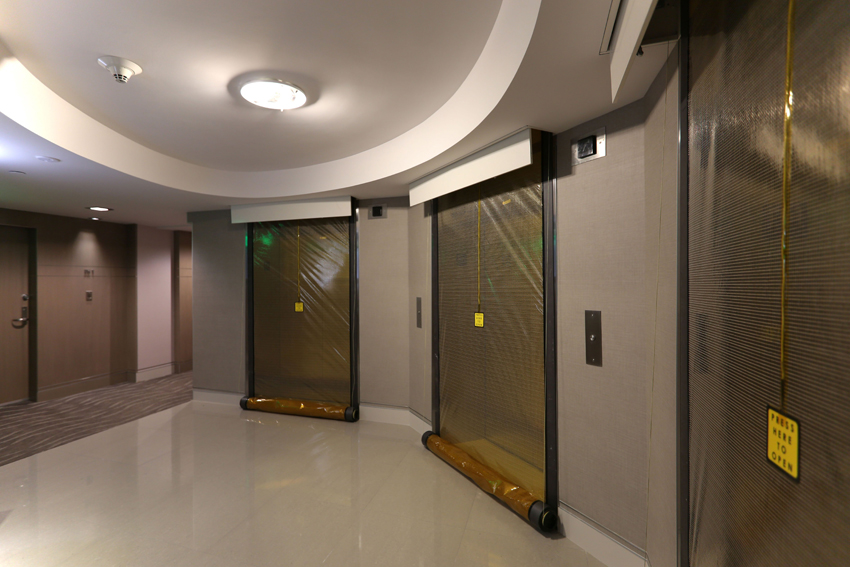
While an overwhelming majority of elevator doors are fire rated, architects must incorporate an additional device or mechanism that delivers the necessary smoke protection at the elevator hoistway.
In laymen’s terms, unless the building type requires smoke compartments like an I-2 (hospital) or requires rated corridors like an R occupancy (apartment or hotel), then when more than three stories are connected by an elevator shaft, architects are required, by IBC, to isolate each floor from the elevator shaft with both fire and smoke protection. While the overwhelming majority of elevator doors are fire rated, additional equipment is necessary to provide the requisite smoke protection. The requirements for smoke protection at elevators are basically concerned with preventing smoke migration in two different directions at an elevator hoistway. They seek to prevent smoke from entering the elevator hoistway through an elevator door and then rising vertically through the shaft. They also want to prevent smoke in an elevator shaft from reentering a floor and traveling down adjacent corridors, further compromising the safe egress of people in the building.
Conventional Smoke-Containment Solutions
There are three conventional solutions that architects choose from when attempting to satisfy the smoke-containment requirement at an elevator hoistway. They can 1) incorporate an enclosed elevator lobby into into the floorplan, 2) pressurize the elevator shaft, or 3) place an additional fire-rated and smokeproof door at the elevator. Let’s take a closer look at the strengths and weaknesses of these conventional solutions.

Three traditional ways of providing smoke control at an elevator door are to create an enclosed elevator lobby, incorporate elevator pressurization, or add a smokeproof swing door to the outside of the elevator doorway.
Enclosed Elevator Lobby
As the name suggests, an enclosed elevator lobby is a room that is built around the elevator doors that can be closed off from the rest of the floor in the event of a fire. The code requires that these lobbies be constructed with walls that have a 1-hour fire rating and doors that have a 20-minute fire rating. The IBC also requires that the walls and doors resist the passage of smoke. The doors or opening protectives must meet the air-leakage performance criteria as outlined by the Underwriters Laboratories (UL) 1784. This test examines the rate that air and smoke leak from one side of the door to the other, and products and door assemblies that pass UL 1784 will appropriately resist the spread of smoke. Doors that have passed the UL 1784 test will receive an S Label.
To meet the fire- and smoke-protection requirements, architects commonly specify fire-rated swing doors that have earned an S Label. These swing doors typically have gaskets, so when the swing doors close, the gasket fills in the empty space between the door and the frame, creating a seal that prevents smoke from leaking out of the vestibule. The enclosed elevator lobby becomes a barrier on the fire floor that keeps smoke from penetrating the elevator shaft and, simultaneously, prevents smoke from migrating out of the elevator shaft onto a non-fire floor.
While an effective smoke partition, the enclosed elevator lobby is space intensive and places parameters on the design that can hinder an architect’s vision, especially in this era of open space. Incorporating enclosed elevator lobbies onto every floor connected by the hoistway requires that a lot of square footage be set aside for use if a fire event occurs, and that amount of space may be able to create a tremendous amount of value if employed another way. A different solution may allow an architect to add one more hotel room or hospital room to the floorplan, or create larger condos, generating more revenue for the building owner from the same footprint.
Elevator Shaft Pressurization System
Elevator shaft pressurization is a code-compliant alternative to the enclosed elevator lobby. This solution is designed to prevent smoke from flowing through an elevator shaft and affecting additional floors during a fire.
Elevator pressurization systems create and maintain a pressure differential between the hoistway and the adjacent elevator landing using large fans to inject large quantities of air into the elevator shaft. With the pressure differential that is created, smoke cannot enter the hoistway or move freely from floor to floor. While many consider elevator pressurization to be a simple and straightforward fan and ductwork solution for smoke control, these systems are incredibly complex. IBC Section 909.21 describes all of the requirements that must be met by the shaft pressurization system.
While elevator shaft pressurization is a more space-savvy smoke-protection solution, it is not a plausible solution for every type of project. Building characteristics such as height, shaft size, and the number of elevator cars in the system must be considered to determine if elevator shaft pressurization is a good fit. In addition, outside temperatures can affect the pressure inside a building. For example, the stack effect, which occurs when the bottom floors are in positive pressure and the upper floors are in negative pressure, and explains how smoke from a first floor fire migrates quickly up the shaft to spread throughout higher floors, can be materially changed during different times of the year. On hot summer days, this stack effect can be reversed due to positive pressure on the top floor and negative pressure on bottom floors, causing smoke from a fire on a roof or top floor to be sucked down through the building and into the lower floors. Designing a pressurized system that will work despite changes in climatic conditions is very difficult.
Please note that while elevator pressurization does help to prevent vertical smoke migration in the shaft, it is not an approved means of transforming an elevator door that is not smoke rated into a smoke-rated door. Where smoke-rated doors are required by code, smoke-rated doors must still be installed.
Additional Smoke-Rated Door
Another solution that can be used to prevent smoke migration at the elevator hoistway in lieu of an enclosed elevator lobby is to mount an additional smoke-rated door at the elevator opening. In many cases, this additional door is described as a gasketed swing door that has been tested in accordance with UL 1784 without an artificial bottom seal for air leakage and is equipped with am undercut drop-down seal and a closer, a device that pulls the door closed when the magnetic hold-open releases. These swing doors can be opened from the elevator car side without the use of a key, tool, knowledge, or special effort, ensuring that if people are in the elevator and the swing doors deploy, people will not be trapped inside. Most states also have elevator codes (ASME A17.1 2013 or newer) that also require a vision panel if a solution like this is used.
Here is how this type of door is designed to work in the event of a fire. In response to a local fire alarm, the magnetic hold-open releases, and the smoke-rated door swings closed over the fire-rated elevator door, providing the code-mandated fire- and smoke-rated barrier necessary for the space. The gasketing along the jamb of the door assembly fills in the space between the swing door and the door frame, creating a seal that prevents smoke from trespassing through it.
While this type of solution offers the smoke protection demanded by the code, there are a few shortcomings that should be considered before moving forward with smoke-rated swing doors on a project. Aesthetically, swing doors parked on the side of an elevator door are not a clean and modern look, and if there are more than two adjacent elevator doors, the hoistways may need to be spaced further apart to accommodate the placement of the open swing doors, which would require a supersized shaft. Also, swing doors are often wedged open by tenants or inadvertently blocked by furnishings on the floor. If these systems are unable to properly close, they are useless as a smoke barrier.
Luckily, there is another type of product that can offer the level of smoke protection required at the elevator door that does not have the aesthetic and functional limitations of the swing door solution or the space needs of the enclosed elevator lobby.
New Smoke-Rated Solution for Elevators
A rolling magnetic gasketing system protects elevator openings and the shaft from vertical smoke migration. It does this by creating a code-compliant smoke- and draft-control assembly when paired with a common fire-rated elevator door. The system deploys a reinforced, transparent, polymide film down over the shaft door when smoke is detected in the area. The edges of the film are equipped with flexible magnetic strips that adhere to the 2-inch-wide ferrous metal rails on either side of the doorway, providing a virtually airtight seal.
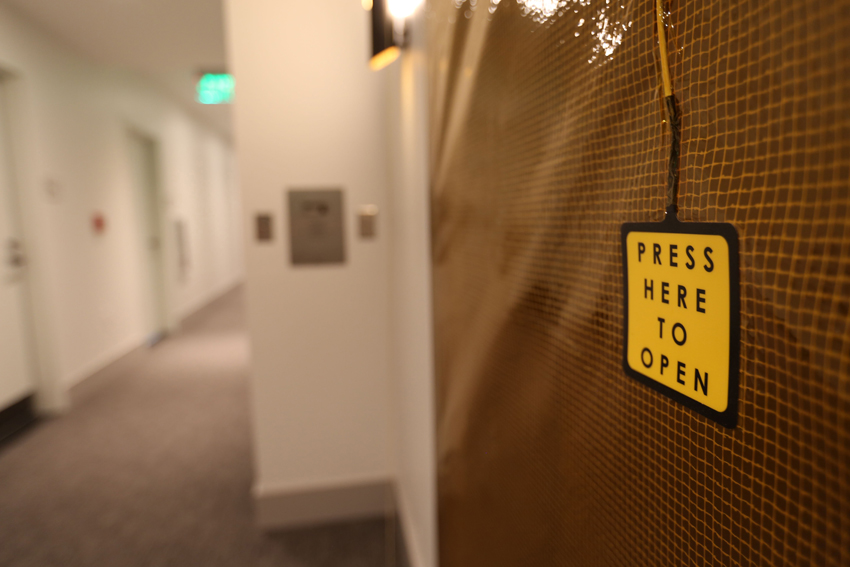
A rolling magnetic gasketing system deploys a reinforced, transparent film over the fire-rated elevator door in a way that creates an airtight seal and provides the smoke protection required by the IBC.
The IBC recognizes the combination of the normally fire-rated elevator hoistway doors and the rolling magnetic gasketing system, which creates an airtight seal over the shaft door, as an approved alternative for an enclosed elevator lobby. The fire-rated elevator doors provide the requisite fire protection, and the UL 1784-tested rolling magnetic gasketing system provides the necessary smoke protection.
Here is how it works. The gasketing system is installed at the elevator opening and integrated with existing fire-protection systems. The release mechanism of the system is connected to the UL-listed smoke detector required by code at the elevator landing. When smoke is detected, the release mechanism deploys the smoke-rated material over the elevator opening. The system is described as a fail-safe device that is gravity deployed, so once released, the film will only stop when the curtain assembly encounters the floor. After the emergency has passed, the screen can be rewound into the housing by activating a switch.
In terms of how this system is incorporated into an elevator opening aesthetically, architects have a few options. The housing that contains the smoke-rated material can be mounted directly above the elevator door frame or more discreetly in the ceiling or valence above the elevator door. The metal rails that flank the elevator opening can be painted to match the interior or left as unpainted stainless steel.
One notable advantage of this technology over others is that these systems offer deployable containment that is activated where fire and smoke are detected, allowing building occupants more time to egress the building.
REQUIRED SMOKE CONTAINMENT IN ATRIUM AND MULTISTORY SPACES
Vertical smoke migration must be considered in other types of interior space beyond the elevator hoistway. The code demands that some degree of smoke protection be incorporated into open, multistory space—whether it is an atrium, a two-story opening, or an open stairway. Interestingly, the specific fire- and smoke-protection measures required in these similar but different types of space can depend upon the type of occupancy and even the way that the architect chooses to define the feature in the floorplan.
Consider this. A 15-foot by 20-foot multistory space in an apartment building that connects only the first and second floors could be classified as either an atrium or a two-story opening. An atrium is defined in Section 202 of the IBC as an “opening connecting two or more stories other than enclosed stairways, elevators, hoistways, escalators, plumbing, electrical, air-conditioning, or other equipment, which is closed at the top and not defined as a mall. Stories, as used in this definition, do not include balconies within assembly groups or mezzanines that comply with Section 505.” A two-story opening is defined, in Section 712.1.9, as a feature that does not connect more than two stories, does not penetrate a smoke compartment, and is not open to a corridor in an I or R occupancy. Section 1020.1 requires a fire-rated separation of an egress corridor in an R occupancy.
The way that the project architect chooses to refer to this type of space can have a dramatic impact on the type and expense of the fire and smoke protection that must be incorporated into it. If the opening is considered an atrium, it would not require a smoke-control system but would require a fire-rated separation from adjacent spaces. Section 404.5 requires a means of smoke control. This system can be either active or passive, although many architects assume that a mechanical smoke-evacuation system is necessary in an atrium. This is an example of a multistory space that does not require a smoke-control system. Section 404.6, Exception 3 allows an atrium to be open to three stories, providing the smoke-control system is designed for it. If the feature is considered a two-story opening, as defined in the IBC, the opening will have to be separated from any corridors and also any occupied spaces. In short, the two-story opening in this scenario would have to be separated from anything.
As an apartment building, it may be advantageous to call this opening an atrium because it would not require a smoke-control system but would require a fire-rated separation from corridors.
But, if the function of this scenario is changed from an apartment building to an assisted-living facility, which is an occupancy group I-1, it would be better to call the feature a two-story opening. With just the change in occupancy type, suddenly the atrium would require smoke control, which, even to outfit the small 15-foot by 20-foot multistory space, could cost $500,000. If it is called a two-story opening instead of an atrium, it would still require the fire-rated separation from corridors, as detailed in Section 1020.1 and Section 712.1.9, and it could not connect smoke compartments, but all of these could be accomplished simultaneously with just a fire-rated separation.
This scenario perfectly illustrates how something as simple as an occupancy change can have an enormous effect on the level and expense of the smoke-protection system that is required by code.
Traditional Multistory Passive Smoke-Containment Solutions
Architects often take a deep breath when they think about incorporating a smoke-evacuation system into a project. It is not that these systems are particularly space-guzzling or complex to incorporate, but they are tremendously expensive, easily costing upward of $1 million. When a code requires smoke control on a project, the compliant systems can be mechanical or passive.
Passive smoke-containment solutions compartmentalize the area and prevent smoke migration. These systems are traditionally divided into one of two categories: permanent or deployable. A permanent smoke-containment solution is permanently in place whether there is an emergency or not. Examples of permanent passive smoke-containment solutions include walls and protective glass that can effectively stop the trespass of smoke across the assembly. However, as trends demand more open space, these permanent constructions, while effective, hamper design.
As architects look for a way to create safe, code-compliant interiors that are open, they need solutions that will provide smoke protection when there is a fire event, without being an ever-present eyesore that compartmentalizes the space during the typical day-to-day. They are seeking deployable fire- and smoke-rated curtains.
New Deployable Fire- and Smoke-Rated Curtains
Fire- and smoke-rated curtains are often divided into three categories: vertical, horizontal, and perimeter. Their category refers to how the curtains are used to divide and protect a space. Vertical curtains create a vertical barrier that can be used to quadron off the central atrium or multistory space from the corridors that flank it, keeping smoke from traveling from the atrium into the corridor or from the corridor into the atrium. Horizontal curtains can be used to reduce the size of a multistory atrium. For example, a three-story atrium can be divided into a two-story space and a one-story space with a horizontal curtain deployed through the opening. A perimeter curtain can be perfectly tailored to frame the shape of the open space. Each of these systems offers designers a deployable solution that creates open space that is equipped with the code-mandated fire- and smoke-rated protectives.
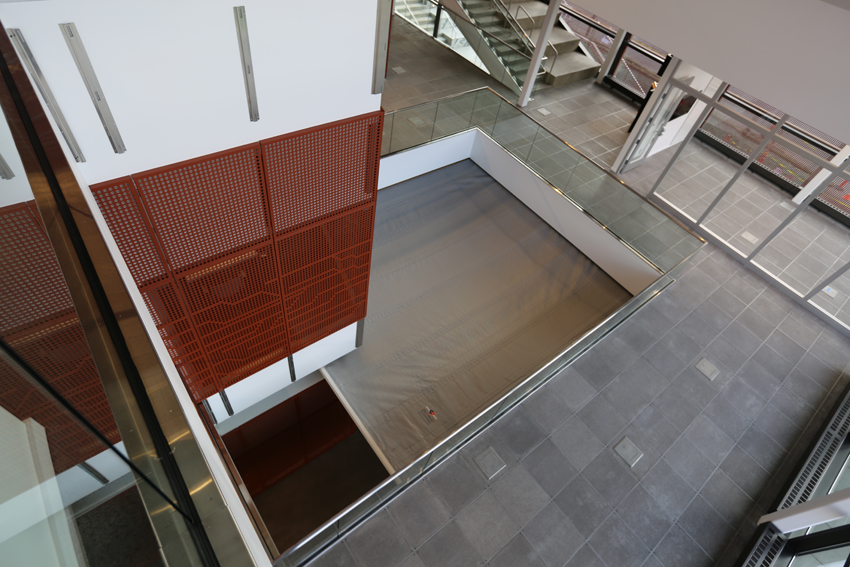
The horizontal fire curtain deploys to provide an opening protective in multistory openings and atriums.
Vertical Fire- and Smoke-Rated Curtain
Vertical fire- and smoke-rated curtains are, as the name suggests, rated for fire and smoke control. Manufactured from a filament glass fabric, vertical curtains have a 2-hour (120-minute) fire-endurance rating from the UL 10D standard and are compliant with the UL 1784 standard for smoke and draft control in assemblies.
These vertical curtains can protect openings in walls, subdivide atriums, and safely separate other specialty enclosures where fire-rated protection is required.
Horizontal Fire-Rated Curtain
Fire-rated horizontally deploying curtains can bisect an atrium between floors, compartmentalizing space. This can be a cost-effective and code-compliant way to avoid a mechanical smoke evacuation system that might otherwise be necessary for the project. The horizontal fire curtain satisfies IBC requirements to provide an opening protective in atrium and lightwell applications.
Perimeter Fire-Rated Curtain
A fire-rated perimeter curtain is a unique fire-rated barrier that can accommodate any number of opening shapes and sizes. The system can be configured in an open shape, such as an L or U, or as a closed shape like a square or hexagon. Another distinguishing feature of a perimeter curtain is that is does not require a corner post, allowing the perimeter curtain to descend into an opening free from structural supports. These curtains are stored in a headbox (193/8 inches deep by 9 inches high) that is typically installed above the ceiling and runs off a building’s standby power system.
CONCLUSION
Through the long lens of history, fire and smoke have illustrated just how dangerous and destructive they can be. Building codes now require what they do in an attempt to prevent past mistakes and avoid repeated and avoidable tragedies from occurring. Luckily, advancements in materials and technology offer architects solutions that enable them to achieve their next-level visions and create contemporary interiors designed for today while incorporating the hard-earned lessons from the past.
Rolling magnetic gasketed systems and fire- and smoke-rated vertical, horizontal, and perimeter curtains are examples of solutions that deliver the code-mandated protections in open, multistory spaces, enabling architects to design large, open spaces and grand central staircases. In addition, these systems are more space savvy and cost-effective than other mechanical systems that have been on the market for years, proving yet again that product innovation is a key support in the quest for cutting-edge and code-compliant design.

